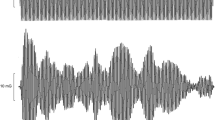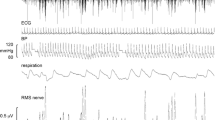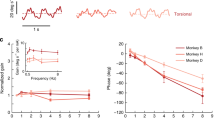Abstract
We recently showed that selective stimulation of one set of otolithic organs—those located in the utricle, sensitive to displacement in the horizontal axis—causes a marked entrainment of skin sympathetic nerve activity (SSNA). Here, we assessed whether muscle sympathetic nerve activity (MSNA) is similarly modulated. MSNA was recorded via tungsten microelectrodes inserted into cutaneous fascicles of the common peroneal nerve in 12 awake subjects, seated (head vertical, eyes closed) on a motorised platform. Slow sinusoidal accelerations–decelerations (±4 mG) were applied in the X (antero-posterior) or Y (medio-lateral) direction at 0.08 Hz. Cross-correlation analysis revealed partial entrainment of MSNA: vestibular modulation was 32 ± 3 % for displacements in the X-axis and 29 ± 3 % in the Y-axis; these were significantly smaller than those evoked in SSNA (97 ± 3 and 91 ± 5 %, respectively). For each sinusoidal cycle, there were two peaks of modulation—one associated with acceleration as the platform moved forward or to the side and one associated with acceleration in the opposite direction. We believe the two peaks reflect inertial displacement of the stereocilia within the utricle during sinusoidal acceleration, which evokes vestibulosympathetic reflexes that are expressed as vestibular modulation of MSNA as well as of SSNA. The smaller vestibular modulation of MSNA can be explained by the dominant modulation of MSNA by the arterial baroreceptors.




Similar content being viewed by others
References
Bent L, Bolton P, Macefield V (2006) Modulation of muscle sympathetic bursts by sinusoidal galvanic vestibular stimulation in human subjects. Exp Brain Res 174:701–711
Bini G, Hagbarth K-E, Wallin BG (1981) Cardiac rhythmicity of skin sympathetic activity recorded from peripheral nerves in man. J Auton Nerv Syst 4:17–24
Carter JR, Ray CA (2008) Sympathetic responses to vestibular activation in humans. Am J Physiol Regul Integr Comp Physiol 294:R681–R688
Cohen B, Yakushin SB, Holstein GR (2012) What does galvanic vestibular stimulation actually activate? Front Neurol 2:90
Delius W, Hagbarth K-E, Hongell A, Wallin BG (1972) Manoeuvres affecting sympathetic outflow in human skin nerves. Acta Physiol Scand 84:177–186
El Sayed K, Dawood T, Hammam E, Macefield VG (2012) Evidence from bilateral recordings of sympathetic nerve activity for lateralization of vestibular contributions to cardiovascular control. Exp Brain Res 221:427–436
Fernández C, Goldberg JM (1976) Physiology of peripheral neurons innervating otolith organs of the squirrel monkey. I. Response to static tilts and to long-duration centrifugal force. J Neurophysiol 39:970–984
Fernández C, Goldberg JM, Baird RA (1990) The vestibular nerve of the chinchilla. III. Peripheral innervation patterns in the utricular macula. J Neurophysiol 63:767–780
Fitzpatrick RC, Day BL (2004) Probing the human vestibular system using galvanic stimulation. J Appl Physiol 96:2301–2316
Goldberg JM, Smith CE, Fernandez C (1984) Relation between discharge regularity and responses to externally applied galvanic currents in vestibular nerve afferents of the squirrel monkey. J Neurophysiol 51:1236–1256
Grewal T, James C, Macefield V (2009) Frequency-dependent modulation of muscle sympathetic nerve activity by sinusoidal galvanic vestibular stimulation in human subjects. Exp Brain Res 197:379–386
Grewal T, Dawood T, Hammam E, Kwok K, Macefield V (2012) Low-frequency physiological activation of the vestibular utricle causes biphasic modulation of skin sympathetic nerve activity in humans. Exp Brain Res 220:101–108
Hammam E, James C, Dawood T, Macefield VG (2011) Low-frequency sinusoidal galvanic stimulation of the left and right vestibular nerves reveals two peaks of modulation in muscle sympathetic nerve activity. Exp Brain Res 213:507–514
Hammam E, Dawood T, Macefield VG (2012) Low-frequency galvanic vestibular stimulation evokes two peaks of modulation in skin sympathetic nerve activity. Exp Brain Res 219:441–446
Holstein GR, Friedrich VL Jr, Kang T, Kukielka E, Martinelli GP (2011) Direct projections from the caudal vestibular nuclei to the ventrolateral medulla in the rat. Neuroscience 175:104–117
Holstein GR, Friedrich VL Jr, Martinelli GP, Ogorodnikov D, Yakushin SB, Cohen B (2012) Fos expression in neurons of the rat vestibulo-autonomic pathway activated by sinusoidal galvanic vestibular stimulation. Front Neurol 3:4
Igarashi M, O-Uchi T, Isago H, Wright WK (1983) Utricular and saccular volumetry in human temporal bones. Acta Otolaryngol 95:75–80
James C, Macefield VG (2010) Competitive interactions between vestibular and cardiac rhythms in the modulation of muscle sympathetic nerve activity. Auton Neurosci 158:127–131
James C, Stathis A, Macefield VG (2010) Vestibular and pulse-related modulation of skin sympathetic nerve activity during sinusoidal galvanic vestibular stimulation in human subjects. Exp Brain Res 202:291–298
Kaufmann H, Biaggioni I, Voustianiouk A, Diedrich A, Costa F, Clarke R, Gizzi M, Raphan T, Cohen B (2002) Vestibular control of sympathetic activity. An otolith-sympathetic reflex in humans. Exp Brain Res 143:463–469
Macefield VG, Wallin BG (1999) Respiratory and cardiac modulation of single vasoconstrictor and sudomotor neurones to human skin. J Physiol 516:303–314
Minor LB, Goldberg JM (1991) Vestibular-nerve inputs to the vestibulo-ocular reflex: a functional ablation study in the squirrel monkey. J Neurosci 11:1636–1648
Paige GD, Tomko DL (1991) Eye movement responses to linear head motion in the squirrel monkey. I. Basic characteristics. J Neurophysiol 65:1170–1182
Spoendlin H (1966) Ultrastructure of the vestibular sense organ. In: Wolfson RJ (ed) The vestibular system and its diseases. University of Pennsylvania Press, Philadephia, pp 39–68
Watanuki K, Schuknecht HF (1976) A morphological study of human vestibular sensory epithelia. Arch Otolaryngol 102:853–858
Yates BJ, Yamagata Y, Bolton PS (1991) The ventrolateral medulla of the cat mediates vestibulosympathetic reflexes. Brain Res 552:265–272
Yates BJ, Goto T, Bolton PS (1993) Responses of neurons in the rostral ventrolateral medulla of the cat to natural vestibular stimulation. Brain Res 601:255–264
Acknowledgments
This work was supported by a Grant from the Australian Research Council to KK and VGM (ARC DP 1096179). The Hong Kong University of Science and Technology manufactured the motion simulator.
Author information
Authors and Affiliations
Corresponding author
Rights and permissions
About this article
Cite this article
Hammam, E., Kwok, K. & Macefield, V.G. Modulation of muscle sympathetic nerve activity by low-frequency physiological activation of the vestibular utricle in awake humans. Exp Brain Res 230, 137–142 (2013). https://doi.org/10.1007/s00221-013-3637-7
Received:
Accepted:
Published:
Issue Date:
DOI: https://doi.org/10.1007/s00221-013-3637-7




